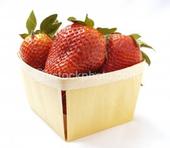The strawberry (Fragaria) is a genus of plants in the family Rosaceae, and the fruit of these plants. There are more than 20 named species and many hybrids and cultivars. The most common strawberries grown commercially are cultivars of the Garden strawberry, a Fragaria ananassa hybrid. Strawberries are a valuable source of vitamin C.
The strawberry is an accessory fruit; that is, the fleshy part is derived not from the ovaries (which are the "seeds", actually achenes) but from the peg at the bottom of the hypanthium that held the ovaries. So from a technical standpoint, the seeds are the actual fruits of the plant, and the flesh of the strawberry is a vegetable. It is greenish-white as it develops and in most species turns red when ripe.
The rosette growth of the plants are a well-known characteristic. Most species send out long slender runners that produce a new bud at the extremity. The leaves typically have three leaflets, but the number of leaflets may be five or one.
While the flower has the typical rosaceous structure, the fruit is very peculiar, but it may be understood by the contrast it presents with the rose hip of the rose. In a rose the top of the flower-stalk expands as it grows into a vase-shaped cavity, the hip, within which are concealed the true fruits or seed-vessels. In the rose the extremity of the floral axis is concave and bears the carpels in its interior. In the strawberry, the floral axis, instead of being concave, swells out into a fleshy, dome-shaped or flattened mass in which the carpels or true fruits, commonly called pips or seeds, are more or less embedded but never wholly concealed. A ripe strawberry in fact may be aptly compared to the fruit of a rose turned inside out.
